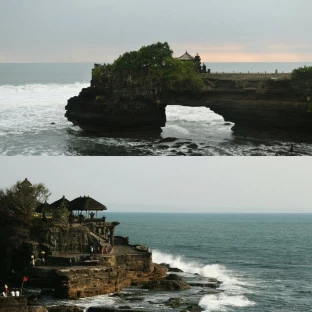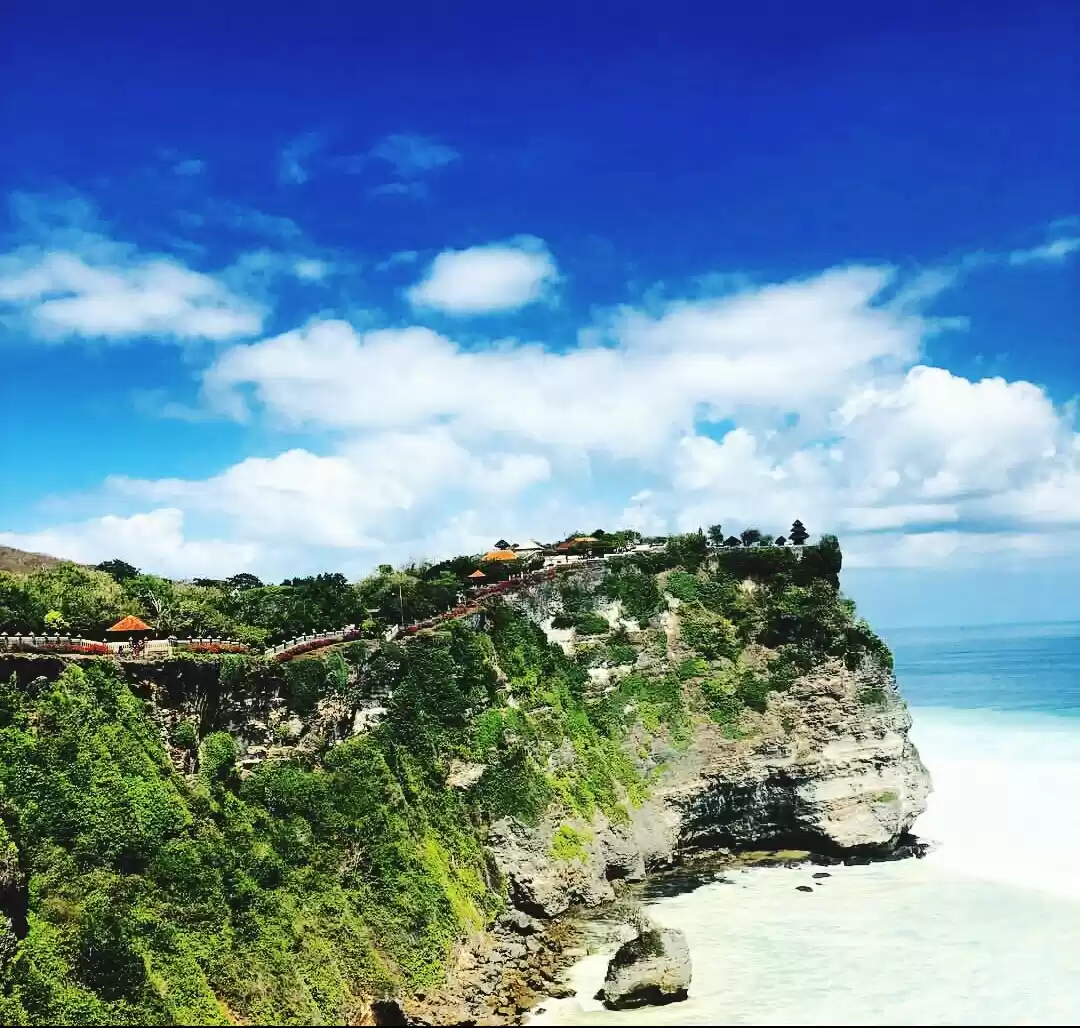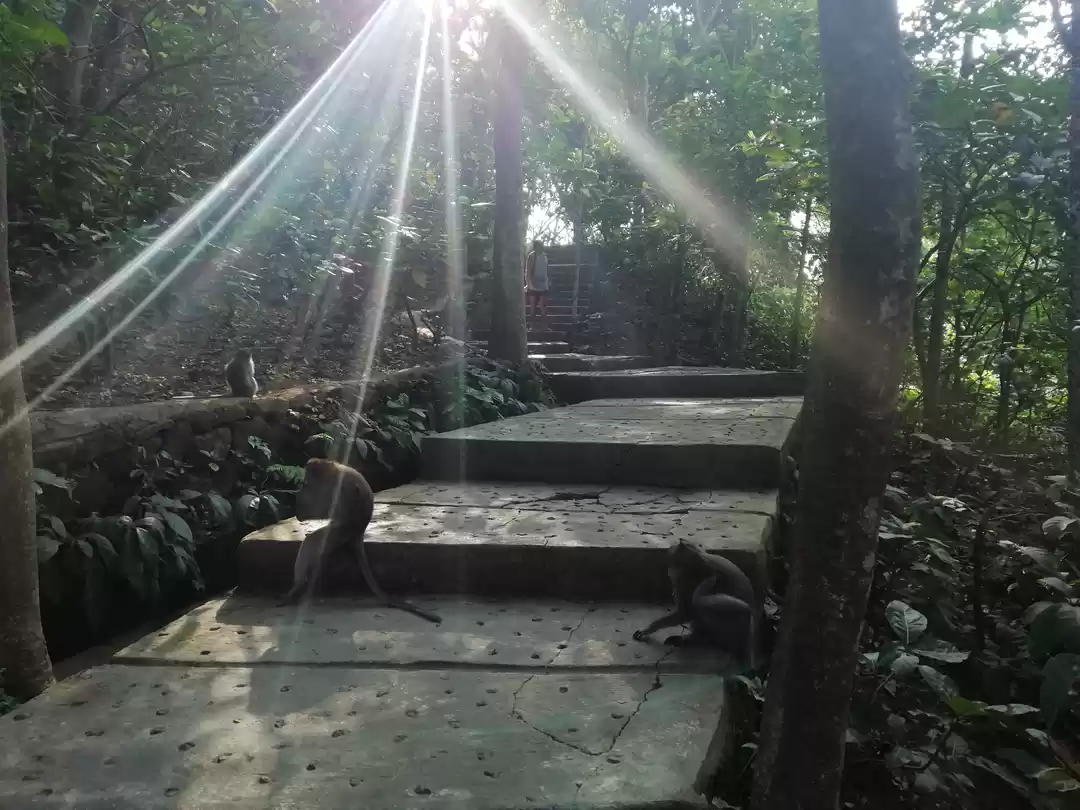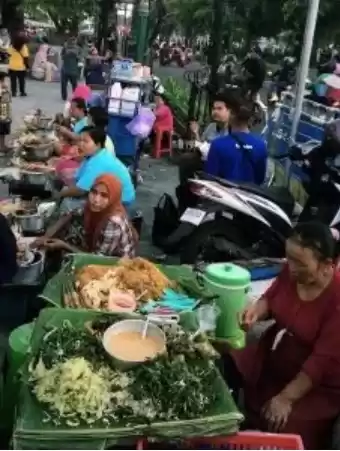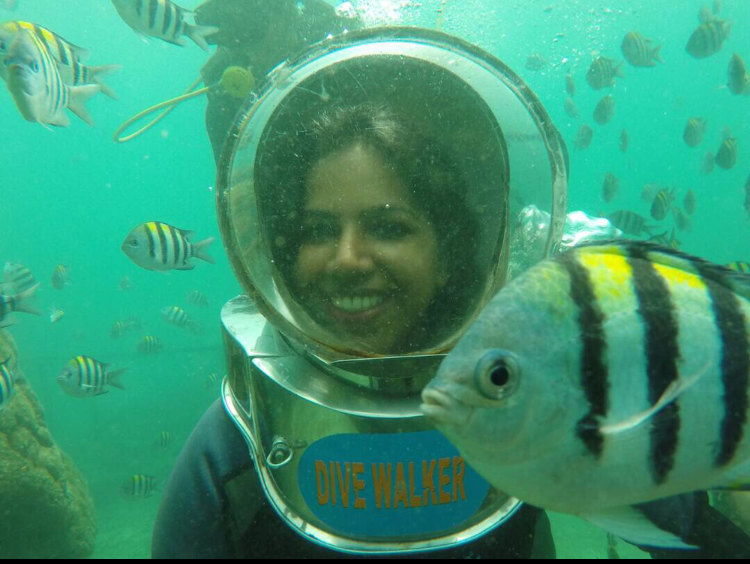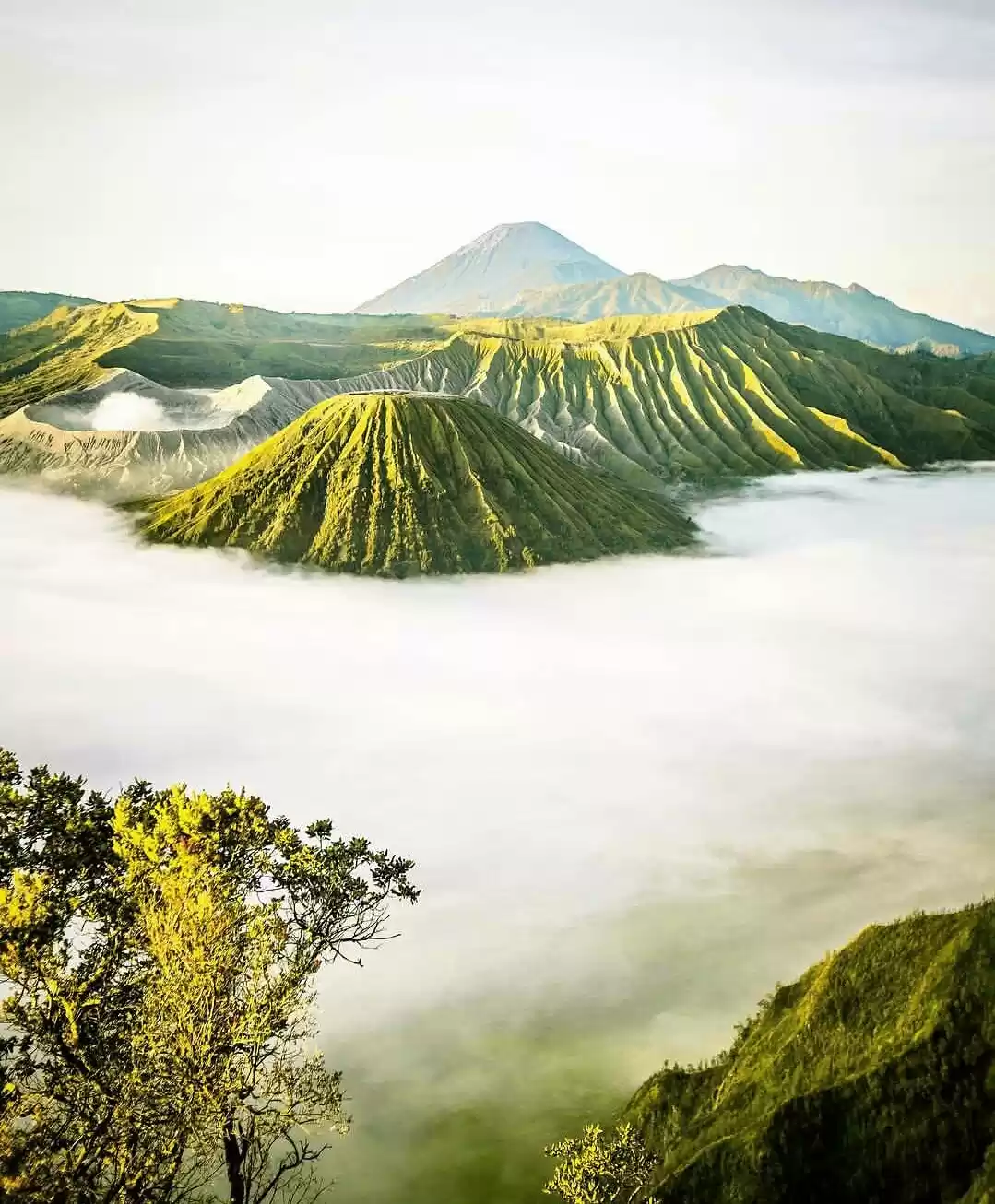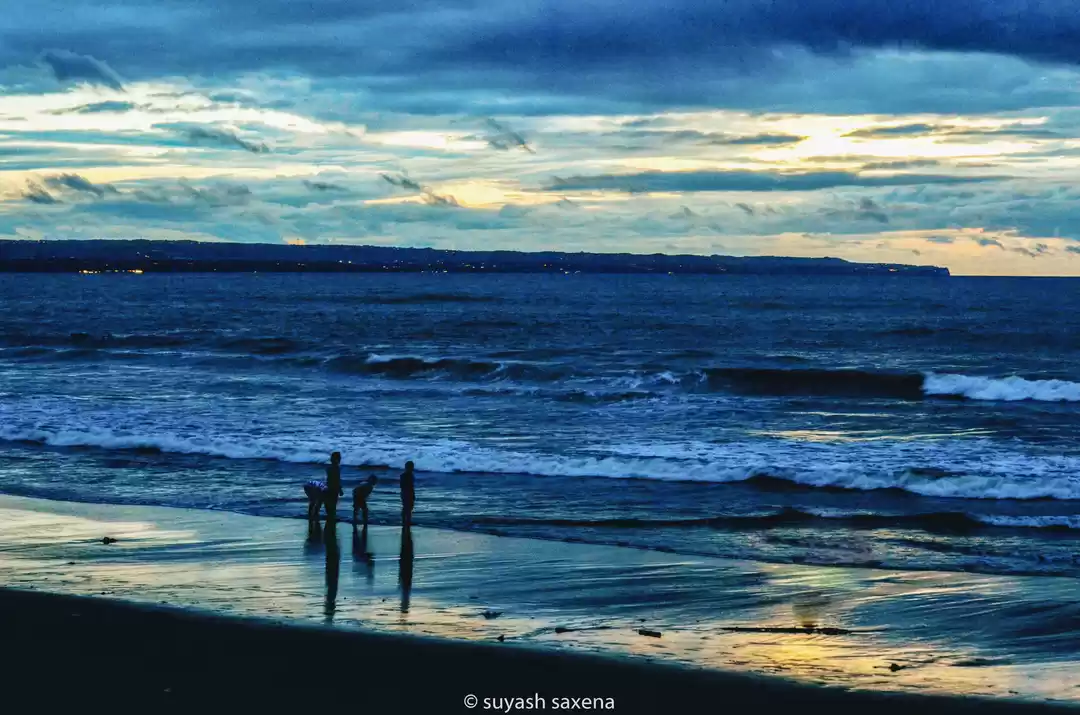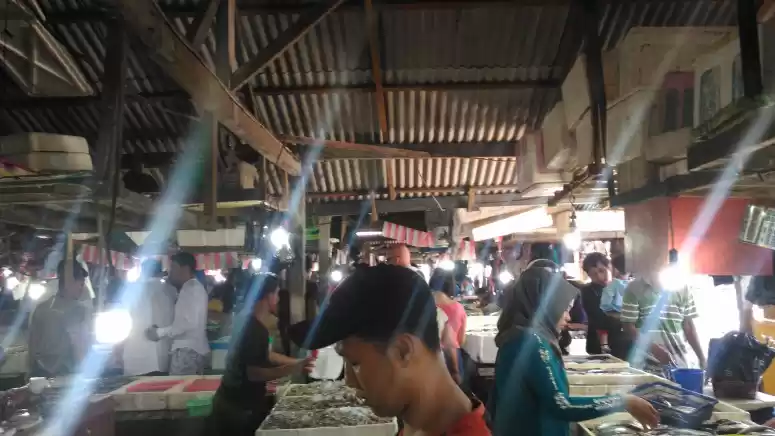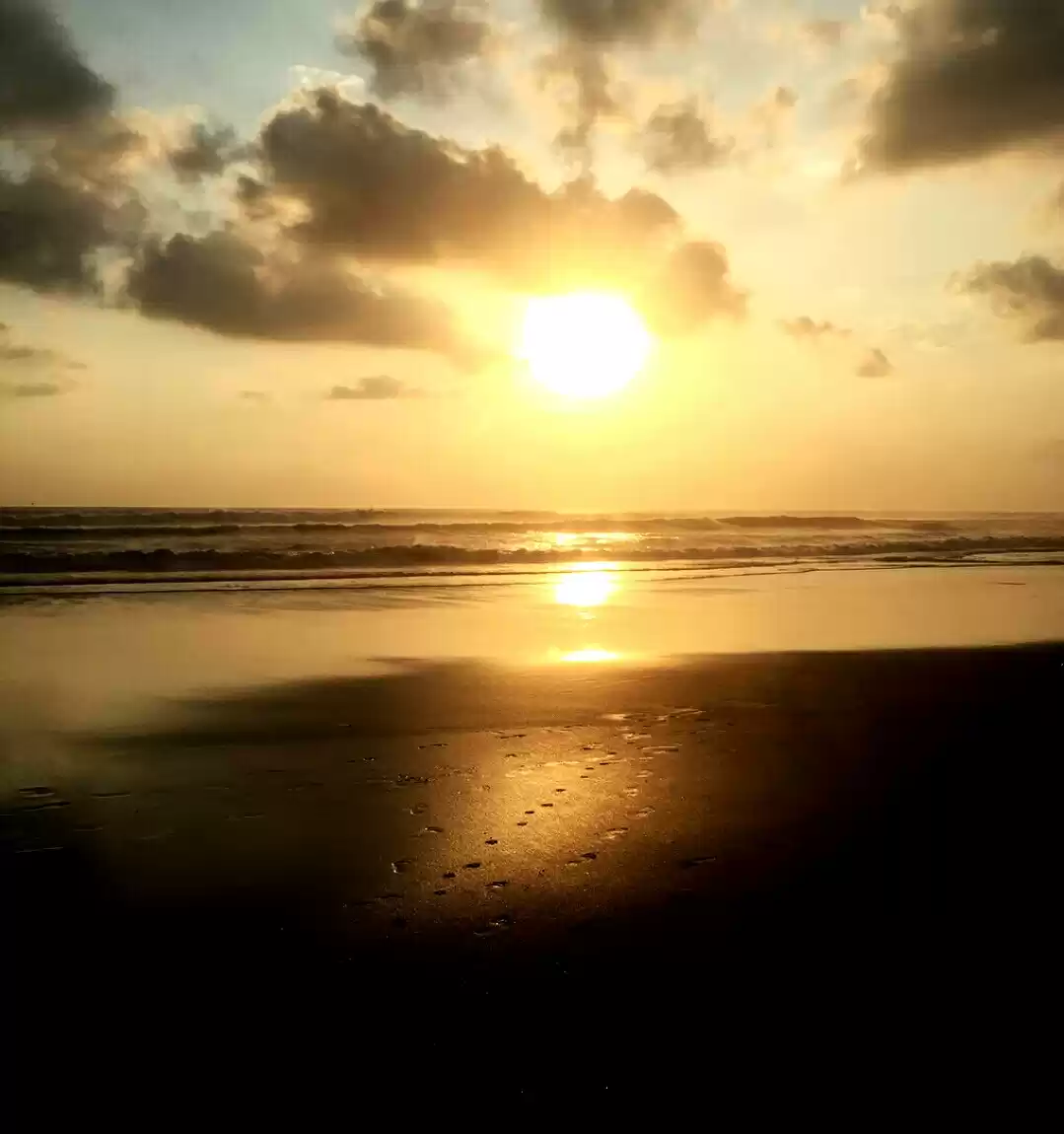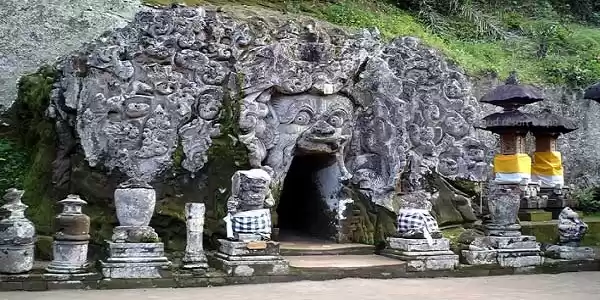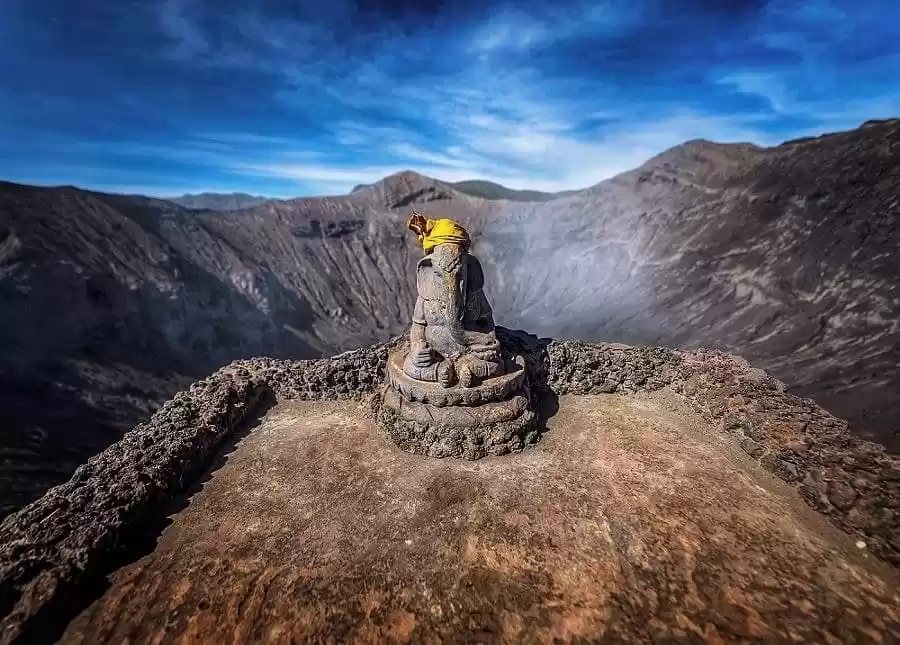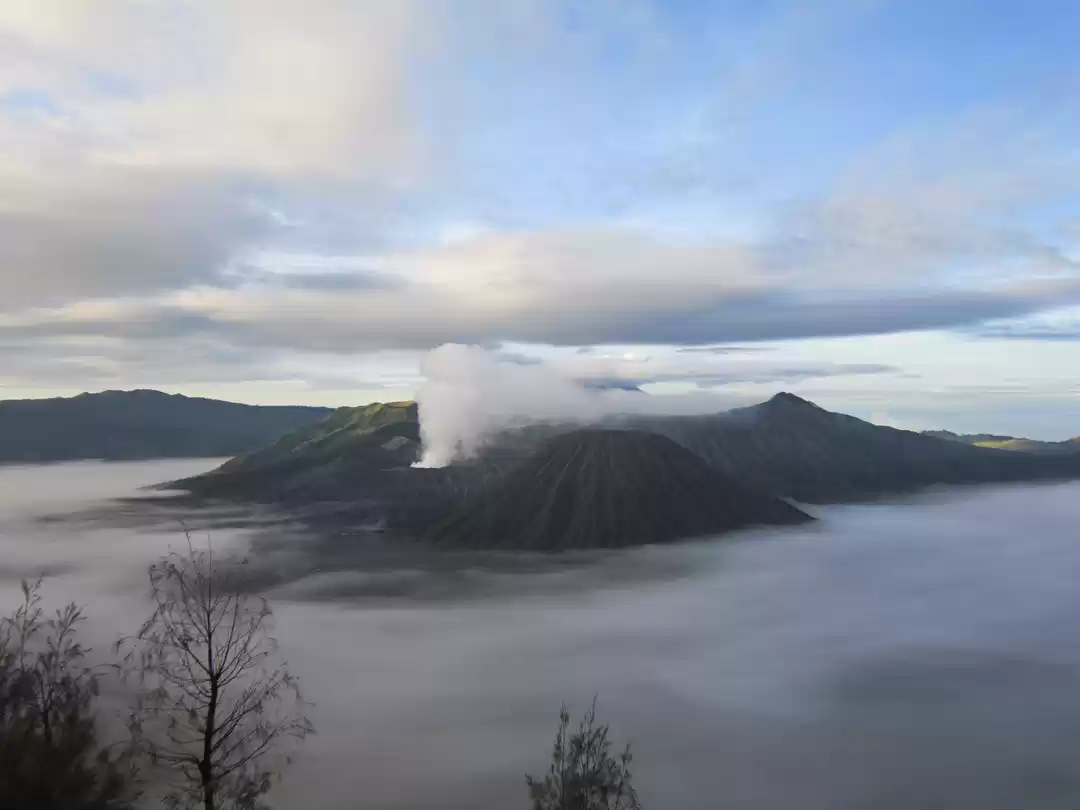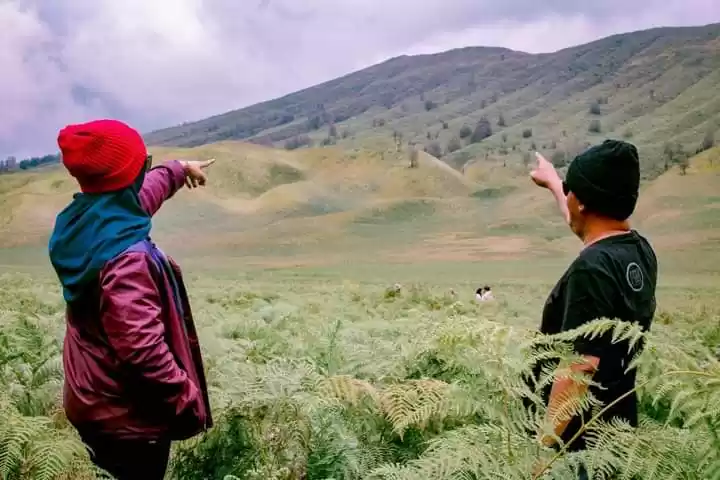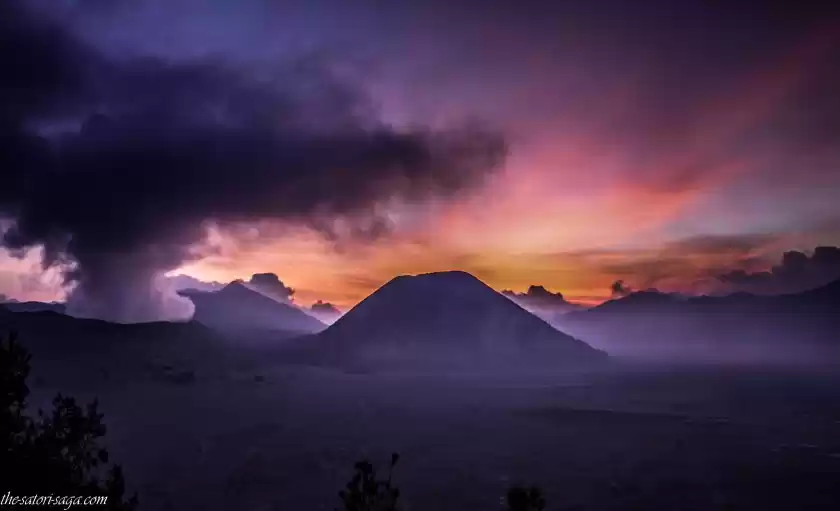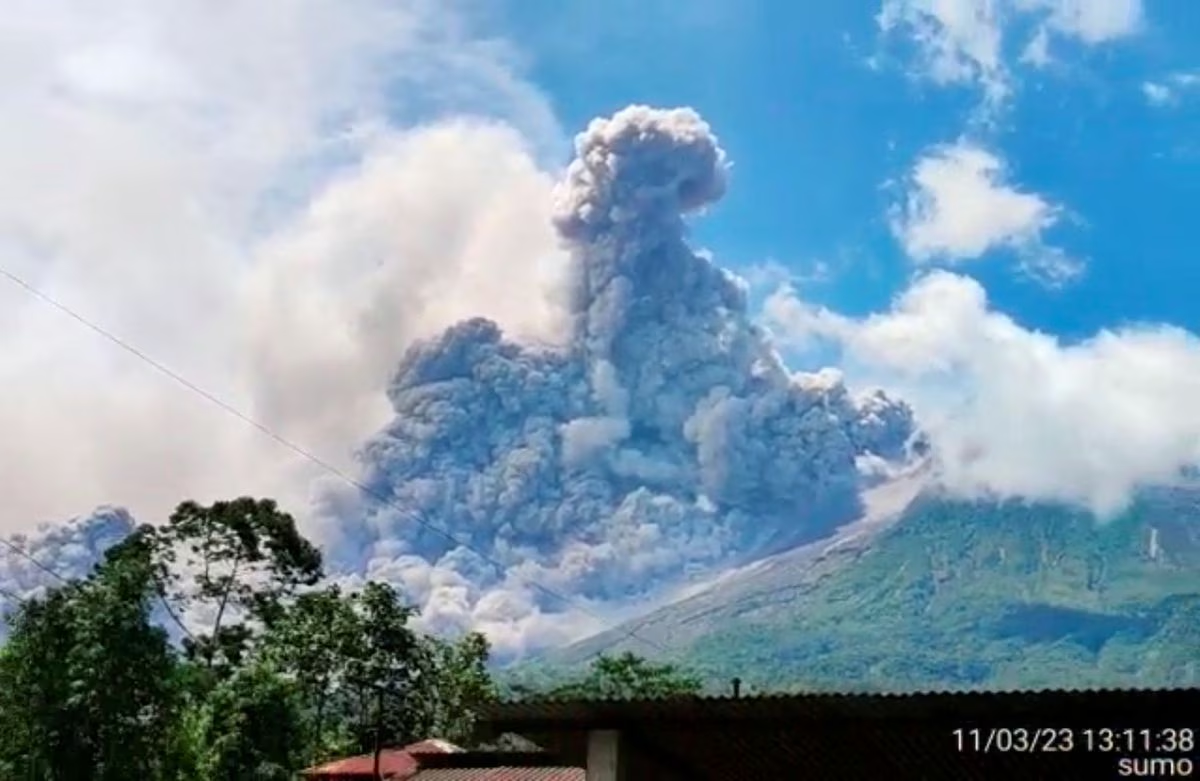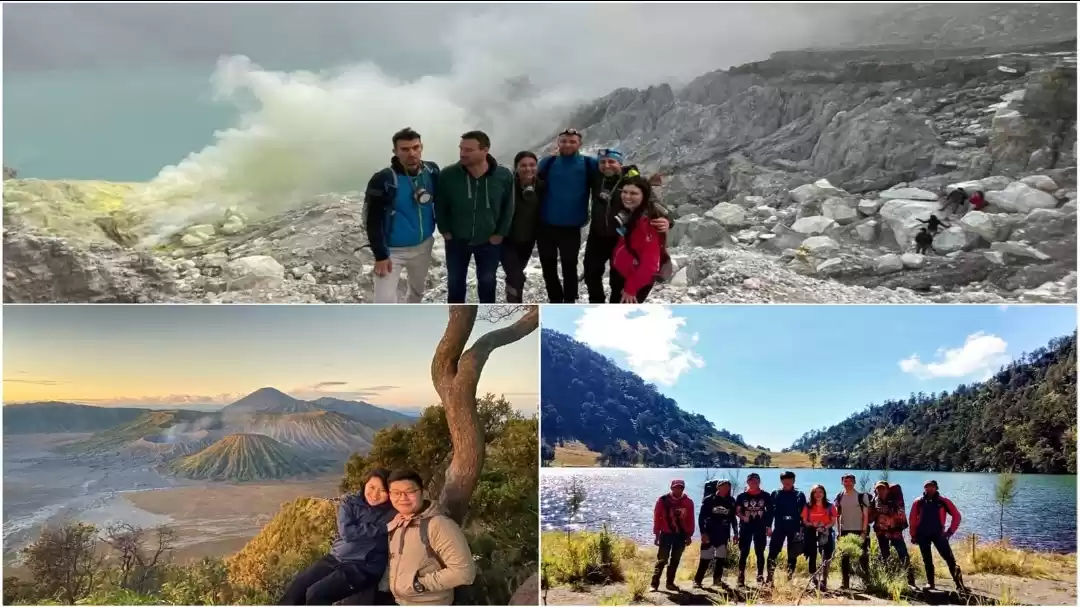Imagine waking up before dawn and driving through the dark and misty landscape to reach a viewpoint overlooking a vast sea of sand. As the sun rises, you witness a spectacular sight: a towering volcano surrounded by four smaller peaks, emitting white smoke and glowing in the morning light. This is Mount Bromo, one of the most incredible volcanoes in the world, and a must-see destination for anyone visiting Indonesia.
Mount Bromo is located in the Bromo Tengger Semeru National Park, a UNESCO Biosphere Reserve that covers an area of 800 square kilometers in East Java. The national park is home to two active volcanoes, Mount Bromo and Mount Semeru, as well as various natural and cultural attractions, such as waterfalls, lakes, forests, and the Tengger people, who are the descendants of the ancient Majapahit kingdom and still practice their ancestral traditions and rituals.
In this guide, you will find everything you need to know about how to get to Mount Bromo, where to stay, how to see the sunrise, how to hike to the crater, and what else to do near Mount Bromo. Whether you choose to join a guided tour or do it on your own, you will have an unforgettable experience of witnessing the beauty and power of nature at its finest.

How to Get to Mount Bromo
Mount Bromo is accessible from various cities and regions in Indonesia, such as Jakarta, Surabaya, Malang, Bali, and Yogyakarta. You can choose to travel by plane, train, bus, car, or motorcycle, depending on your budget, time, and preference. Here are some of the most common ways to reach Mount Bromo from different locations:
- From Jakarta: The capital city of Indonesia is about 800 kilometers away from Mount Bromo, and the fastest way to get there is by plane. You can fly from Jakarta to Surabaya, the second-largest city in Indonesia and the closest major city to Mount Bromo, in about an hour. From Surabaya, you can take a bus, a car, or a motorcycle to Mount Bromo, which will take another 3 to 4 hours. The plane ticket will cost you around 500,000 IDR ($35 USD) one way, and the bus, car, or motorcycle rental will cost you around 100,000 to 300,000 IDR ($7 to $21 USD) one way. The advantage of flying from Jakarta to Surabaya is that you can save time and avoid the traffic and congestion on the road. The disadvantage is that you will miss the scenic views and the local culture along the way.
- From Surabaya: If you are already in Surabaya, or you have flown there from Jakarta or another city, you can take a bus, a car, or a motorcycle to Mount Bromo, which will take about 3 to 4 hours. You can find buses from Surabaya to Probolinggo, a town near Mount Bromo, at the Bungurasih Bus Terminal, which run every 15 to 30 minutes from 5 am to 9 pm. The bus ticket will cost you around 30,000 IDR ($2 USD) one way. From Probolinggo, you can take another bus, a minivan, or a jeep to Cemoro Lawang, a village at the edge of the sea of sand, where most of the accommodation options near Mount Bromo are located. The bus, minivan, or jeep ticket will cost you around 50,000 to 100,000 IDR ($3 to $7 USD) one way. The advantage of taking a bus from Surabaya to Mount Bromo is that you can save money and meet other travelers along the way. The disadvantage is that you will have to deal with the hassle and uncertainty of finding and waiting for the buses, minivans, or jeeps, especially during peak season or holidays.
- From Malang: Another city that is close to Mount Bromo is Malang, which is about 100 kilometers away and has its own airport. You can fly from Jakarta or another city to Malang in about an hour, and the plane ticket will cost you around 400,000 IDR ($28 USD) one way. From Malang, you can take a car or a motorcycle to Mount Bromo, which will take about 2 to 3 hours. The car or motorcycle rental will cost you around 200,000 to 300,000 IDR ($14 to $21 USD) one way. The advantage of flying from Jakarta or another city to Malang is that you can avoid the traffic and congestion in Surabaya, and enjoy the charming and historical city of Malang, which has many attractions and activities of its own. The disadvantage is that you will have to pay more for the plane ticket and the car or motorcycle rental, and you will miss the bus option from Surabaya to Probolinggo.
- From Bali: If you are coming from Bali, the island of the gods, you can take a ferry, a bus, a car, or a motorcycle to Mount Bromo, which will take about 10 to 12 hours. You can find ferries from Gilimanuk, a port in the west of Bali, to Ketapang, a port in the east of Java, which run every 15 to 30 minutes, 24 hours a day. The ferry ticket will cost you around 10,000 IDR ($0.7 USD) one way. From Ketapang, you can take a bus, a car, or a motorcycle to Mount Bromo, which will take another 8 to 10 hours. The bus, car, or motorcycle rental will cost you around 200,000 to 400,000 IDR ($14 to $28 USD) one way. The advantage of taking a ferry, a bus, a car, or a motorcycle from Bali to Mount Bromo is that you can experience the diversity and beauty of Indonesia, from the beaches and temples of Bali, to the mountains and volcanoes of Java. The disadvantage is that you will spend a lot of time and energy on the road, and you will have to deal with the hassle and uncertainty of finding and waiting for the ferries, buses, cars, or motorcycles, especially during peak season or holidays.
Where to Stay Near Mount Bromo
There are many accommodation options near Mount Bromo, ranging from budget to luxury, and from urban to rural. You can choose to stay in Surabaya, Malang, Probolinggo, or Cemoro Lawang, depending on your budget, preference, and itinerary. Here are some of the best places to stay near Mount Bromo, categorized by location and price:
- Surabaya: If you want to stay in a big and modern city, with plenty of facilities and attractions, you can stay in Surabaya, which is about 3 to 4 hours away from Mount Bromo. You can find hotels, hostels, guesthouses, and homestays in Surabaya, with prices ranging from 100,000 to 1,000,000 IDR ($7 to $70 USD) per night. Some of the best places to stay in Surabaya are:
Hotel Majapahit Surabaya: This is a 5-star hotel that offers luxury and elegance in the heart of Surabaya. The hotel features spacious and stylish rooms, a spa, a pool, a gym, a restaurant, a bar, and a garden. The hotel is also a historical landmark, as it was the site of the famous flag-raising incident that marked the beginning of the Indonesian independence movement in 1945. The hotel is located near the Tunjungan Plaza, the largest shopping mall in Surabaya, and the Surabaya Zoo, the oldest zoo in Indonesia. The price for a night at the Hotel Majapahit Surabaya is around 900,000 IDR ($63 USD).
Krowi Inn: This is a 2-star hostel that offers comfort and convenience in the center of Surabaya. The hostel features cozy and clean rooms, a shared kitchen, a lounge, a terrace, and a garden. The hostel also offers free breakfast, free Wi-Fi, free parking, and free bicycle rental. The hostel is located near the House of Sampoerna, a museum and factory that showcases the history and culture of the Sampoerna cigarette company, and the Surabaya Heritage Trail, a walking tour that explores the colonial and historical buildings of Surabaya. The price for a night at the Krowi Inn is around 100,000 IDR ($7 USD).
- Malang: If you want to stay in a charming and historical city, with plenty of attractions and activities, you can stay in Malang, which is about 2 to 3 hours away from Mount Bromo. You can find hotels, hostels, guesthouses, and homestays in Malang, with prices ranging from 100,000 to 800,000 IDR ($7 to $56 USD) per night. Some of the best places to stay in Malang are:
Bromo Backpacker Hostel: This is a 2-star hostel that offers convenience and affordability in the outskirts of Probolinggo. The hostel features dormitory and private rooms, a shared kitchen, a lounge, a terrace, and a garden. The hostel also offers free breakfast, free Wi-Fi, free parking, and free shuttle service to Mount Bromo. The hostel is located near the Bromo Permai Hotel, which is a popular meeting point for tours and jeeps to Mount Bromo. The price for a night at the Bromo Backpacker Hostel is around 100,000 IDR ($7 USD).
- Cemoro Lawang: If you want to stay as close as possible to Mount Bromo, you can stay in Cemoro Lawang, a village at the edge of the sea of sand, which is about 15 minutes away from Mount Bromo. You can find hotels, hostels, guesthouses, and homestays in Cemoro Lawang, with prices ranging from 100,000 to 600,000 IDR ($7 to $42 USD) per night. Some of the best places to stay in Cemoro Lawang are:
Jiwa Jawa Resort Bromo: This is a 4-star resort that offers luxury and tranquility in the midst of nature. The resort features elegant and spacious rooms, a spa, a pool, a gym, a restaurant, a bar, and a gallery. The resort also offers stunning views of Mount Bromo and Mount Batok, and organizes various activities and events, such as yoga, meditation, photography, and music. The resort is located near the Cemoro Lawang Entrance Gate, which is the main access point to the sea of sand and Mount Bromo. The price for a night at the Jiwa Jawa Resort Bromo is around 600,000 IDR ($42 USD).
Cafe Lava Hostel: This is a 2-star hostel that offers comfort and convenience in the center of Cemoro Lawang. The hostel features cozy and clean rooms, a shared kitchen, a lounge, a terrace, and a garden. The hostel also offers free breakfast, free Wi-Fi, free parking, and free information and assistance for Mount Bromo tours and jeeps. The hostel is located near the Cemara Indah Hotel, which is another popular meeting point for tours and jeeps to Mount Bromo. The price for a night at the Cafe Lava Hostel is around 200,000 IDR ($14 USD).
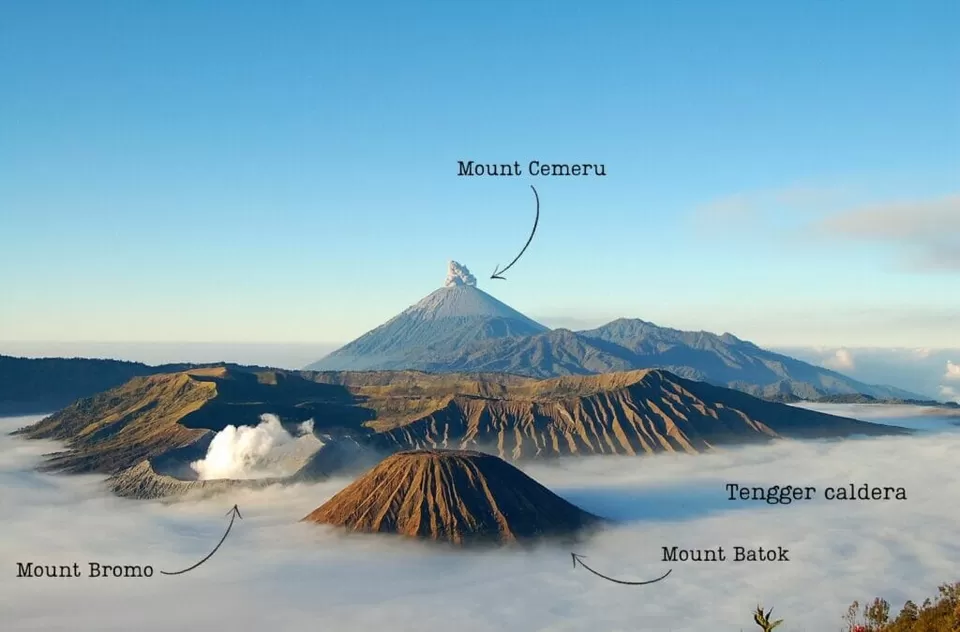
How to Visit Mount Bromo for Sunrise
One of the main reasons to visit Mount Bromo is to see the sunrise, which is considered one of the most spectacular and magical sights in the world. The sunrise view from Mount Bromo is not only breathtaking, but also symbolic, as it represents the harmony and balance between nature and culture, as well as the hope and renewal of life.
There are two ways to visit Mount Bromo for sunrise: joining a guided tour or doing it on your own. Both options have their pros and cons, and you can choose the one that suits your budget, preference, and itinerary. Here are some tips and advice for both options:
- Joining a guided tour: This is the easiest and most convenient way to visit Mount Bromo for sunrise, as you don't have to worry about the transportation, the accommodation, the entrance fee, or the guide. You can book a tour package from Surabaya, Malang, Probolinggo, or Cemoro Lawang, which will include a jeep, a driver, a guide, a hotel, and a breakfast. The tour package will cost you around 500,000 to 1,000,000 IDR ($35 to $70 USD) per person, depending on the duration, the quality, and the inclusions of the tour. The advantage of joining a guided tour is that you can save time and hassle, and enjoy the sunrise view with a professional and knowledgeable guide, who will explain the history and culture of Mount Bromo and the Tengger people, and take you to the best viewpoints and attractions. The disadvantage of joining a guided tour is that you will have less flexibility and freedom, and you will have to share the jeep and the guide with other tourists, which may affect your comfort and privacy.
- Doing it on your own: This is the more adventurous and challenging way to visit Mount Bromo for sunrise, as you have to arrange everything by yourself, such as the transportation, the accommodation, the entrance fee, and the guide. You can rent a jeep, a car, or a motorcycle from Surabaya, Malang, Probolinggo, or Cemoro Lawang, which will cost you around 300,000 to 600,000 IDR ($21 to $42 USD) per day, depending on the type, the condition, and the availability of the vehicle. You can also hire a local guide from Cemoro Lawang, which will cost you around 100,000 to 200,000 IDR ($7 to $14 USD) per day, depending on the experience and the language skills of the guide. The advantage of doing it on your own is that you can have more flexibility and freedom, and explore Mount Bromo at your own pace and preference, and discover some hidden gems and off-the-beaten-path spots. The disadvantage of doing it on your own is that you will spend more time and energy, and face more risks and uncertainties, such as getting lost, getting stuck, or getting scammed.
- How to hike to the crater rim and the top of Mount Bromo: After watching the sunrise, you can continue your adventure by hiking to the crater rim and the option to climb to the top of Mount Bromo, which will give you a closer and more thrilling view of the volcano and its surroundings. The hike to the crater rim and the top of Mount Bromo is not very difficult, but it requires some physical fitness and endurance, as well as some safety and environmental precautions. Here are some tips and advice for the hike:
- The distance and the difficulty: The hike to the crater rim and the top of Mount Bromo is about 3 kilometers long, and it will take you about an hour to complete. The hike starts from the sea of sand, which is a flat and sandy area that surrounds the volcano. You can walk, rent a jeep, or hire a horse to cross the sea of sand, which will take you about 15 to 30 minutes. The hike then continues to the crater rim, which is a steep and rocky path that leads to the edge of the volcano. You can walk or climb to the crater rim, which will take you about 30 to 45 minutes. The hike then ends at the top of Mount Bromo, which is a narrow and slippery path that leads to the summit of the volcano. You can climb to the top of Mount Bromo, which will take you about 15 to 30 minutes, or you can skip this option and stay at the crater rim.
- The safety and the environmental issues: The hike to the crater rim and the top of Mount Bromo is not very dangerous, but it involves some risks and challenges, such as the smoke, the dust, and the littering. The smoke is the white and sulfuric gas that comes out of the volcano, and it can cause irritation and discomfort to your eyes, nose, throat, and lungs. The dust is the fine and volcanic ash that covers the sea of sand, the crater rim, and the top of Mount Bromo, and it can make the hike slippery and dirty. The littering is the waste and garbage that some tourists leave behind on the sea of sand, the crater rim, and the top of Mount Bromo, and it can harm the environment and the wildlife. To avoid or minimize these issues, you should wear a mask, sunglasses, and a hat, and bring a bottle of water, a snack, and a trash bag. You should also follow the rules and regulations of the national park, and respect the nature and the culture of Mount Bromo and the Tengger people.
- The best time, weather, and season: The best time to hike to the crater rim and the top of Mount Bromo is right after the sunrise, as the temperature is cooler, the visibility is clearer, and the crowd is smaller. The weather at Mount Bromo is unpredictable, and it can change from sunny to cloudy to rainy in a matter of minutes. The season at Mount Bromo is divided into two: the dry season and the rainy season. The dry season is from April to October, and the rainy season is from November to March. The dry season is the best season to hike to the crater rim and the top of Mount Bromo, as the weather is more stable, the sky is more blue, and the sunrise is more colorful. The rainy season is the worst season to hike to the crater rim and the top of Mount Bromo, as the weather is more unstable, the sky is more gray, and the sunrise is more dull.
- The tips and tricks: The hike to the crater rim and the top of Mount Bromo is a rewarding and memorable experience, but it can also be a challenging and exhausting one. To make the most of your hike, you should follow some tips and tricks, such as:
- Prepare well: Before you hike to the crater rim and the top of Mount Bromo, you should make sure that you are physically and mentally ready, and that you have all the necessary equipment and supplies. You should also check the weather forecast, the sunrise time, and the entrance fee, and plan your itinerary accordingly.
- Enjoy the view: During your hike to the crater rim and the top of Mount Bromo, you should take your time and enjoy the view, as you will see some of the most amazing and stunning scenery in the world, such as the sea of sand, the other volcanoes, the clouds, and the sunrise. You should also take some photos and videos, but don't forget to live in the moment and appreciate the beauty and wonder of nature.
- Respect the volcano: After your hike to the crater rim and the top of Mount Bromo, you should remember that you have just visited one of the most sacred and powerful places in Indonesia, and that you should respect the volcano and its surroundings. You should not throw any stones, coins, or offerings into the crater, as it can disturb the volcanic activity and the spiritual balance. You should also not take any rocks, sand, or plants from the volcano, as it can affect the ecological system and the cultural value. You should also not make any noise, graffiti, or vandalism on the volcano, as it can offend the nature and the culture of Mount Bromo and the Tengger people.
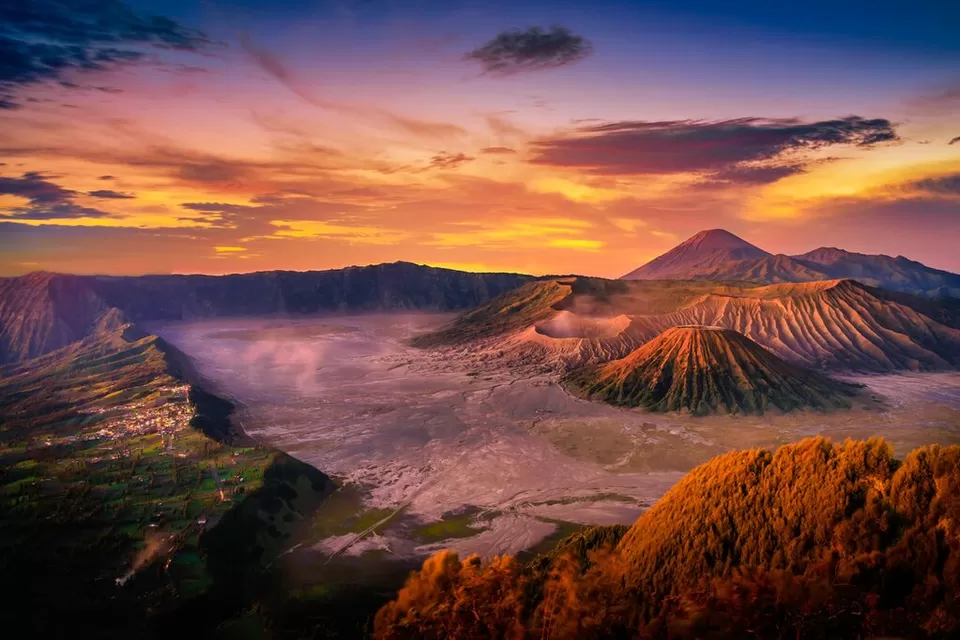
What Else to See and Do Near Mount Bromo
Mount Bromo is not the only attraction in the Bromo Tengger Semeru National Park, as there are many other things to see and do near the volcano, such as the sea of sand, the savanna, the whispering sand, the Teletubbies hill, the Madakaripura waterfall, the Ranu Pane lake, and the Mount Semeru trek. These attractions and activities will give you a more complete and diverse experience of the national park, as you will discover its different landscapes, wildlife, and culture. Here are some of the best things to see and do near Mount Bromo, categorized by type and difficulty:
- The sea of sand: This is a flat and sandy area that surrounds Mount Bromo, and it is one of the most iconic and unique features of the national park. The sea of sand is about 10 kilometers long and 6 kilometers wide, and it is formed by the volcanic ash and dust that are blown by the wind. The sea of sand is also a sacred and cultural site, as it is where the Tengger people perform their annual ceremony of Yadnya Kasada, which is a ritual of offering fruits, vegetables, flowers, and animals to the gods and the ancestors. The sea of sand is easy to see and do, as you can walk, rent a jeep, or hire a horse to cross it, and it will take you about 15 to 30 minutes. The sea of sand is best seen and done in the morning, as the temperature is cooler, the visibility is clearer, and the crowd is smaller.
- The savanna: This is a green and grassy area that lies on the south of Mount Bromo, and it is one of the most contrasting and surprising features of the national park. The savanna is about 5 kilometers long and 3 kilometers wide, and it is home to various plants and animals, such as pine trees, ferns, orchids, deer, monkeys, and birds. The savanna is also a scenic and recreational site, as it offers a panoramic view of Mount Bromo and Mount Semeru, and it is a popular spot for camping, picnicking, and playing. The savanna is easy to see and do, as you can walk, rent a jeep, or hire a horse to reach it, and it will take you about 30 to 45 minutes. The savanna is best seen and done in the afternoon, as the temperature is warmer, the color is greener, and the atmosphere is livelier.
- The whispering sand: This is a dark and dusty area that lies on the west of Mount Bromo, and it is one of the most mysterious and eerie features of the national park. The whispering sand is about 3 kilometers long and 2 kilometers wide, and it is named after the sound that it makes when the wind blows over it, which resembles a whisper or a hiss. The whispering sand is also a historical and cultural site, as it is where the Dutch colonial army fought against the Indonesian independence fighters in 1948, and it is where the Tengger people bury their dead. The whispering sand is moderate to see and do, as you can walk, rent a jeep, or hire a horse to explore it, and it will take you about 45 to 60 minutes. The whispering sand is best seen and done in the evening, as the temperature is cooler, the sound is louder, and the mood is darker.
- The Teletubbies hill: This is a hilly and colorful area that lies on the north of Mount Bromo, and it is one of the most fun and playful features of the national park. The Teletubbies hill is about 2 kilometers long and 1 kilometer wide, and it is named after the children's TV show that features four characters with different colors and shapes, who live on a similar hill. The Teletubbies hill is also a beautiful and natural site, as it offers a stunning view of Mount Bromo and Mount Batok, and it is covered with various flowers and grasses, such as edelweiss, lavender, and clover. The Teletubbies hill is easy to see and do, as you can walk, rent a jeep, or hire a horse to enjoy it, and it will take you about 15 to 30 minutes. The Teletubbies hill is best seen and done in the morning, as the temperature is cooler, the light is softer.
- The Teletubbies hill is best seen and done in the morning, as the temperature is cooler, the light is softer, and the flowers are fresher.
- The Madakaripura waterfall: This is a spectacular and majestic waterfall that lies on the northeast of Mount Bromo, and it is one of the most impressive and awe-inspiring features of the national park. The Madakaripura waterfall is about 200 meters high and 20 meters wide, and it is the highest waterfall in Java and the second highest waterfall in Indonesia. The Madakaripura waterfall is also a sacred and historical site, as it is believed to be the final meditation place of Gajah Mada, the legendary prime minister of the Majapahit kingdom, who unified the archipelago in the 14th century. The Madakaripura waterfall is hard to see and do, as you have to walk, rent a jeep, or hire a motorcycle to reach it, and it will take you about an hour and a half. You also have to hike through a rocky and slippery path, and cross a river and a cave, to reach the waterfall, which will take you another 30 to 45 minutes. The Madakaripura waterfall is best seen and done in the afternoon, as the temperature is warmer, the water is clearer, and the rainbow is brighter.
- The Ranu Pane lake: This is a serene and peaceful lake that lies on the southeast of Mount Bromo, and it is one of the most relaxing and refreshing features of the national park. The Ranu Pane lake is about 1 kilometer long and 0.5 kilometer wide, and it is the largest and the highest lake in the national park, at an altitude of 2,200 meters above sea level. The Ranu Pane lake is also a natural and cultural site, as it is a source of water and fish for the local people, and it is a starting point for the Mount Semeru trek, which is the highest and the most challenging trek in Java. The Ranu Pane lake is moderate to see and do, as you can walk, rent a jeep, or hire a motorcycle to enjoy it, and it will take you about an hour. The Ranu Pane lake is best seen and done in the evening, as the temperature is cooler, the wind is calmer, and the reflection is clearer.
- The Mount Semeru trek: This is an adventurous and rewarding trek that leads to the summit of Mount Semeru, the highest and the most active volcano in Java, and one of the most challenging and rewarding treks in Indonesia. The Mount Semeru trek is about 40 kilometers long, and it will take you about 2 to 3 days to complete. The trek starts from the Ranu Pane lake, and passes through various terrains and altitudes, such as forests, meadows, hills, and craters. The trek ends at the Mahameru peak, which is the summit of Mount Semeru, at an altitude of 3,676 meters above sea level. The Mount Semeru trek is also a spiritual and mystical site, as it is believed to be the abode of the gods and the ancestors, and it is where the Tengger people perform their annual ceremony of Yadnya Kasada, which is a ritual of offering fruits, vegetables, flowers, and animals to the gods and the ancestors. The Mount Semeru trek is hard to see and do, as you have to be physically and mentally fit, and you have to bring all the necessary equipment and supplies, such as a tent, a sleeping bag, a stove, a food, and a water. You also have to register and pay the entrance fee at the national park office, and follow the rules and regulations of the national park, such as the hiking schedule, the camping site, and the garbage disposal. The Mount Semeru trek is best seen and done in the dry season, from April to October, as the weather is more stable, the trail is more dry, and the view is more clear.
Conclusion
Mount Bromo is one of the most amazing and stunning volcanoes in the world, and a must-see destination for anyone visiting Indonesia. In this guide, you have learned everything you need to know about how to get to Mount Bromo, where to stay, how to see the sunrise, how to hike to the crater, and what else to do near Mount Bromo.
Whether you choose to join a guided tour or do it on your own, you will have an unforgettable experience of witnessing the beauty and power of nature at its finest.


























